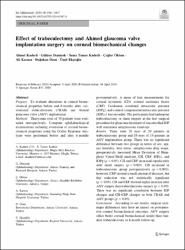Effect of trabeculectomy and Ahmed glaucoma valve implantation surgery on corneal biomechanical changes

View/
Date
2020Author
Kaderli, AhmetDemirok, Gulizar
Kaderli, Sema Tamer
Oktem, Caglar
Karnaz, Ali
Ozen, Dogukan
Eksioglu, Umit
Metadata
Show full item recordAbstract
Purpose To evaluate alterations in corneal biomechanical properties before and 6 months after conventional trabeculectomy (TRAB) and Ahmed glaucoma valve (AGV) implantation. Methods Thirty-nine eyes of 39 patients were evaluated retrospectively. Complete ophthalmological examinations including evaluation of corneal biomechanical properties using the Ocular Response Analyzer were performed before and after 6 months postoperatively. A mean of four measurements for corneal hysteresis (CH), corneal resistance factor (CRF), Goldmann correlated intraocular pressure (IOPg), and corneal compensated intraocular pressure (IOPcc) was recorded. The participants had undergone trabeculectomy or shunt surgery as the first surgical procedure for glaucoma treatment of uncontrolled IOP with maximum antiglaucoma eyedrops. Results There were 20 eyes of 20 patients in trabeculectomy group and 19 eyes of 19 patients in AGV implantation group. There was no significant difference between two groups in terms of sex, age, eye laterality, lens status, antiglaucoma drug usage, preoperatively measured Mean Deviation of Humphrey Visual Field Analyzer, CH, CRF, IOPcc, and IOPg (p > 0.05). CH and CRF increased significantly after shunt surgery (p < 0.001). CH increased in trabeculectomy group postoperatively (p < 0.001); however, CRF showed a small amount of decrease, but this reduction was not statistically significant (p > 0.05). CH and CRF showed higher increase after AGV surgery than trabeculectomy surgery (p < 0.05). There was no significant correlation between IOP changes and CH-CRF changes in both TRAB and AGV groups (p > 0.05). Conclusion According to our results, surgical technique differences may have an impact on postoperative corneal biomechanical outcomes. AGV surgery offers better corneal biomechanical results than standard trabeculectomy in 6-month follow-up.

















